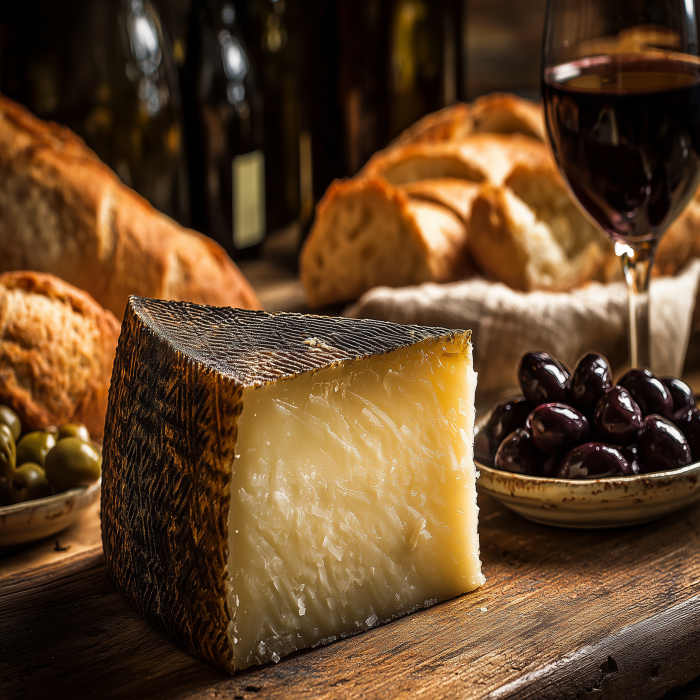The Soul of the Queso: Discovering the Heart of Spanish Cheeses through Their Milk
JUNE 22, 2025

When we think of Spanish cheese, the illustrious Manchego often jumps to mind. Yet Spain’s cheese heritage is a rich mosaic far beyond this famous sheep’s milk cheese. With over 150 varieties and 29 protected quality designations (DOPs and IGPs), Spain’s diverse cheeses owe their distinctiveness mostly to one key ingredient: the milk. The source of the milk—sheep, cow, goat, or a blend—not only dictates flavor and texture but is also a reflection of Spain’s diverse geography and culture.
Spain’s dramatic landscapes—from lush northern pastures to arid plateaus and rugged Mediterranean coasts—have shaped what livestock thrive and, consequently, which kinds of cheeses flourish. The verdant north, including Galicia and Asturias, is the homeland of cow's milk cheeses—mild, creamy, and beloved by locals. The central Meseta's dry plains have birthed the iconic sheep’s milk cheeses like Manchego, celebrated worldwide for their rich, nutty profiles. In the challenging terrains along the Mediterranean and the Canary Islands, resilient goat’s milk cheeses shine, offering intense flavors unique to those regions.
For Pagosa Springs residents and visitors looking to explore this dairy diversity, local Murray’s Cheese inside City Market offers a wonderful selection of Spanish cheeses, allowing you to taste authentic expressions of these unique milk sources.
Beyond individual cheeses, the Spanish system of Denominación de Origen Protegida (DOP) and Indicación Geográfica Protegida (IGP) ensures authenticity by tying cheeses to their geographical origins and traditional production methods. This not only preserves heritage but guarantees quality.
Interestingly, while cow’s milk cheeses dominate in volume, sheep’s milk cheeses like Manchego occupy the cultural spotlight internationally. This paradox highlights how marketing narratives intertwine with culinary tradition—the story of hardy Manchega sheep roaming the sun-drenched Spanish heartland captivates far beyond the palate.
Pagosa’s cheese lovers might particularly appreciate Manchego’s rich history. For those seeking adventure, goat’s milk varieties such as Murcia’s “Drunken Goat,” with its rind washed in local wine, offer a bold and memorable taste.
The art of blending milks also finds a place in Spanish cheesemaking, especially in mountainous regions where herders keep mixed flocks. Blue cheeses like Cabrales and Valdeón shine here, with bold, cave-aged flavors that tell stories of alpine pastures and traditional methods.
Spain’s cheese story is also one of resilience: historic transhumance (seasonal livestock migration) enriched cheese complexity, while the Franco era's suppression of artisanal cheese making challenged producers, only to inspire a vibrant revival post-1975.
Today, Spanish cheesemakers face the challenge of balancing tradition with a modern market inundated by cheaper imports. Supporting these cheeses supports not only rich flavors but rural livelihoods and native breeds.
So next time you’re in Pagosa Springs, stop by City Market’s Murray’s Cheese and savor the soul of Spanish cheese—the flavor of its land, animals, and centuries-old craft, all in one bite.
Spain’s dramatic landscapes—from lush northern pastures to arid plateaus and rugged Mediterranean coasts—have shaped what livestock thrive and, consequently, which kinds of cheeses flourish. The verdant north, including Galicia and Asturias, is the homeland of cow's milk cheeses—mild, creamy, and beloved by locals. The central Meseta's dry plains have birthed the iconic sheep’s milk cheeses like Manchego, celebrated worldwide for their rich, nutty profiles. In the challenging terrains along the Mediterranean and the Canary Islands, resilient goat’s milk cheeses shine, offering intense flavors unique to those regions.
For Pagosa Springs residents and visitors looking to explore this dairy diversity, local Murray’s Cheese inside City Market offers a wonderful selection of Spanish cheeses, allowing you to taste authentic expressions of these unique milk sources.
Beyond individual cheeses, the Spanish system of Denominación de Origen Protegida (DOP) and Indicación Geográfica Protegida (IGP) ensures authenticity by tying cheeses to their geographical origins and traditional production methods. This not only preserves heritage but guarantees quality.
Interestingly, while cow’s milk cheeses dominate in volume, sheep’s milk cheeses like Manchego occupy the cultural spotlight internationally. This paradox highlights how marketing narratives intertwine with culinary tradition—the story of hardy Manchega sheep roaming the sun-drenched Spanish heartland captivates far beyond the palate.
Pagosa’s cheese lovers might particularly appreciate Manchego’s rich history. For those seeking adventure, goat’s milk varieties such as Murcia’s “Drunken Goat,” with its rind washed in local wine, offer a bold and memorable taste.
The art of blending milks also finds a place in Spanish cheesemaking, especially in mountainous regions where herders keep mixed flocks. Blue cheeses like Cabrales and Valdeón shine here, with bold, cave-aged flavors that tell stories of alpine pastures and traditional methods.
Spain’s cheese story is also one of resilience: historic transhumance (seasonal livestock migration) enriched cheese complexity, while the Franco era's suppression of artisanal cheese making challenged producers, only to inspire a vibrant revival post-1975.
Today, Spanish cheesemakers face the challenge of balancing tradition with a modern market inundated by cheaper imports. Supporting these cheeses supports not only rich flavors but rural livelihoods and native breeds.
So next time you’re in Pagosa Springs, stop by City Market’s Murray’s Cheese and savor the soul of Spanish cheese—the flavor of its land, animals, and centuries-old craft, all in one bite.
More in